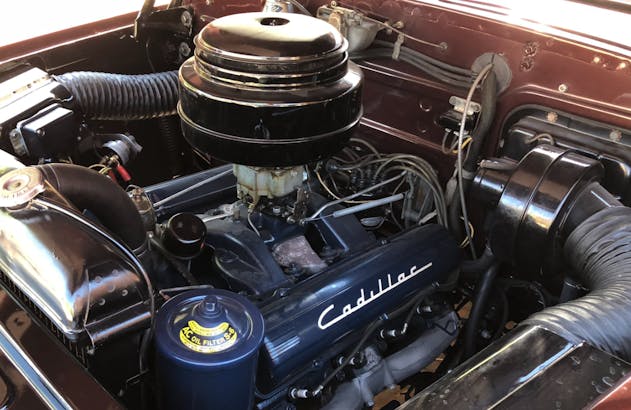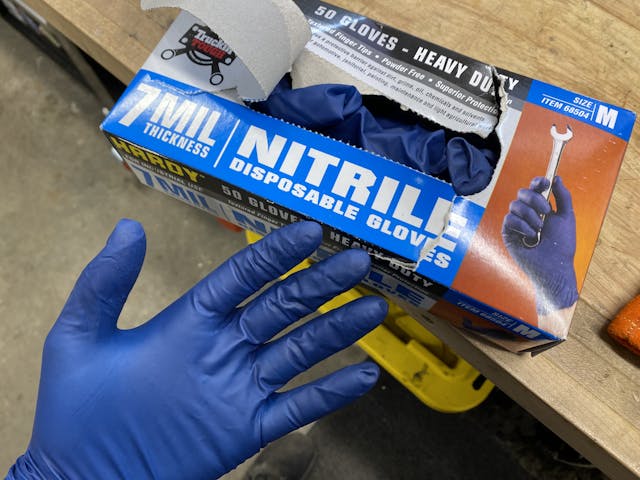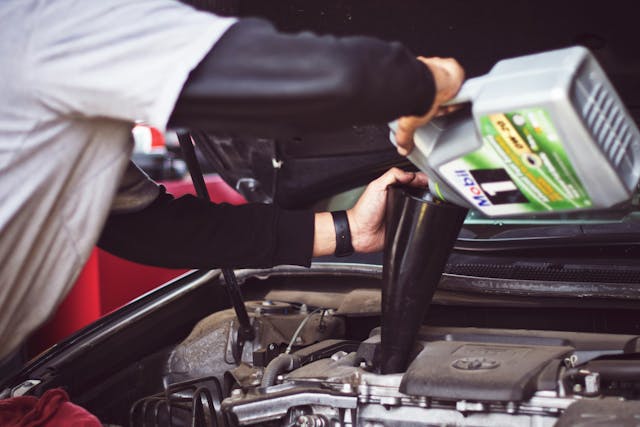8 oil change dos and don’ts
It’s a small job that somehow became a rite of passage for gearheads: Oil changes. The draining and refilling of engine oil is the first task that many budding wrench-turners undertake, and its certainly an important one. Like any other task in the automotive world, there are some pieces of institutional knowledge that comprise the key dos and don’ts for a smooth oil change. So let’s put these lessons learned out in the open, with the mission of shortening the process for newbies. And perhaps to reinforce some best practices for you veteran mechanics?
Don’t go crazy with warm-up

Modern oils are pretty amazing at suspending particles and contaminants, but there is still some junk that sinks down to the bottom of the pan. It needs to be stirred up to ensure it escapes when you pull the drain plug. Starting the engine and letting it idle for a minute or two is perfect for that final circulation. Run it any longer and you’re rewarded with nothing more than scalding hot oil that does nothing more than burn you. Before you pull that (drain) plug, give the engine a minute after shutting down, allowing the oil to drain to the pan from the nooks and crannies higher in the engine. But before you get underneath the vehicle to do the deed, remember you must…
Wear disposable gloves

Nitrile gloves keep you from soaking up solvents and oils into your skin. I’ve found 7mil thick to be a nice sweet spot of durable and affordable.
We all know the guy at the auto parts counter who has seriously gnarly hands from all the years being soaked in oil over decades of engine builds. That’s the visible damage. The invisible damage is sitting in your internal organs. All the hydrocarbons that get absorbed through the skin and are processed in our gut where they can’t be broken down. They end up accumulating in our body, which can cause serious health complications after years and years of chemical exposure. Preventing those issues is easy as putting on a pair of nitrile gloves. Use them even if it’s only for pulling the filter and drain plug, which you can do efficiently with…
The drain plug trick

It’s not groundbreaking, but nothing feels better than the perfect pull on a drain plug to ensure you don’t get any oil on your hand. The trick is pressure, not pulling. As you unthread the plug by hand, push in–against the bolt as in comes out–so the threads act as a seal with the outer edge. With a little practice you can get the pressure right (while not rocking the plug in the threads) and can spin the plug a full turn to feel for the “click.” That click means the bolt overlapped the last thread. With a swift motion away from the direction of oil flow, remove that now-loose plug. Presto! This can make thin viscosity oil changes much cleaner, and thick stuff like 20-50 can sometimes be spotless. In your excitement of not having a mess to clean up after draining, make sure you…
Don’t over tighten the drain plug or filter

It’s come to the point where stuck filters and stripped drain plugs are no longer a joke. Neither the filter nor plug require any real torque when installed properly. Use a small amount of oil to lube the filter’s rubber seal, then spin it into place. After the gasket seats on the housing, turn it only about three-quarter of an additional turn. Some applications might call for a full turn, but that is usually reserved for heavy duty equipment. Any tighter than what the filter manufacturers call for and you run the risk of deforming that rubber seal, which could cause oil to leak past the seal. That’s bad news. Any oil spillage is bad, so when you are filling…
Just use a funnel

The oil fill port on most engines is in that perfect spot where it looks like you could pour directly into it, except that’s a lie. They seem to be ideally located, but cleaning up if you miss (by even the smallest margin) can be a major pain. Are we really going to work so hard to spot and address leaks, to keep our engines clean, and just ruin it while doing routine maintenance?
I’m not. A funnel all but guarantees I won’t have to do any clean up after filling, even if I’m distracted or letting my 7 year-old niece do the filling. Putting in that fresh oil feels good, but be careful and…
Don’t overfill

This shows the rotating assembly without the oil pan and it’s easy to tell how oil at too high of a level would be bad.
Too much oil is just as bad as not enough. Seriously. The oil level in a wet-sump engine is carefully calculated to keep the rotating assembly from whipping through the oil. That action causes foaming, and oil foam pushed through the oiling system is the same as not having oil at all. I don’t need to tell you how bad that can be, so check the service or owners manual for the proper fill level. When done, look at the dipstick as a double check. Luckily, the empty oil containers you now have at this point are are perfect to…
Recycle your used oil

It’s never been easier to properly recycle used oil, so there is no excuse to do otherwise. Just about any auto parts store takes it, so they should be your first trip in your freshly serviced vehicle to “return” your oil. Be sure to capture oil in a non-contaminated pan so that the oil can actually be recycled. Coolant is the main enemy here, so be sure to flush your drain pan before the oil change. Luckily you don’t have to worry about how dusty or dirty the pan is, but other fluids can defeat the purpose of recycling. But before you make the trip to recycle the oil, be sure to…
Reset the computer (or write down your service date)

Modern cars have an oil life monitoring system. Whether you trust it is a personal preference, but for the sake of eliminating confusion, go ahead and reset it now. Most reset procedures involves cycling the ignition key and pressing the throttle pedal a certain number of times. The service manual will outline it, or a quick search to an online make/model specific forum will have the instructions. If your vehicles are of the manual variety, write down the oil change date in a log book. Or consider service tracker kept in the car or garage, as it keeps you from forgetting what’s been done. Not to mention thisa paper trail shows good stewardship to a potential next owner, which can mean an easier sale for more money.
In all, oil changes can be simple and rewarding for newbies and DIY enthusiasts alike. Following these best practices will not only keep your vehicle happy, but also make the experience better for you each time. Do you have something specific you add to this process? Let us know about it in the comments below.
***
Check out the Hagerty Media homepage so you don’t miss a single story, or better yet, bookmark it. To get our best stories delivered right to your inbox, subscribe to our newsletters.



Lots of great tips. Only one I can add here a if it’s a classic or vintage car I’d torque bolts with appropriate torque wrench on the oil pan and valve covers as they do seem to get loose & oil weeps past seal. See your assembly manual for specs.
A note related to oil changes. Newer cars have plastic ring handles on their dipsticks that sometimes break, leaving the remainder of the plastic along with the metal dipstick stuck in the tube.
They can be a real pain to get out of the tube.
I had an 09 Challenger 5.7 that the dipstick got harder and harder to pull out to check the oil. Then one day, the ring broke off. What a pain to get out!! I drilled holes in the part stuck in the tube, screwed a wood screw into it, and pried it out. With great difficulty to get the leverage to fully remove it.
New dipsticks cost around $20, maybe replace them every 7 or 8 years? If nothing else, if your dipstick gets at all difficult to pull out of the tube, replace it now! It’ll be the best $20 you’ll spend.
Wouldn’t have been a prudent thing to do with the twin oil filters that mounted “upside down” at the front top side of the V-12 in my ’69 Ferrari 365 GTC!! LOL
There was a filter called I believe “Frans” that you just changed a toilet roll and add a quart to the crankcase and never change the oil. The oil companies bought them out. they had a demonstration with two clear plexiglass tanks filling the one with old dirty oil and seeing the other side come clean.
It was difficult to change the oil on my 6 cylinder boat engine. Not difficult to remove the plug but no room to get a pan in there to catch the oil in. I used a garbage bag once but that ended in a mess. So I drilled a hole in the plug, tapped it with a 1/4” pipe tap and threaded a nipple and ball valve in it. Another nipple and cap on the valve outlet. Then I could remove the cap, push on a hose run through the bilge drain into a can out the back of the boat. Works like a charm and no more mess anywhere, in or out.👍
Where I live the recycle truck picks up our cans and paper every 2 weeks. They will take used oil as well.
I pour it back into the plastic jug it came in and mark it “used motor oil” with a magic marker. They take it every time.
I change the oil on my turbo summer car in the fall just before storage after a warmup drive, because the oil filter is upside down i let the oil drain overnight take the filter off the next morning, this saves a mess from oil leaking from the filter and all over the block, when i fill with new synthetic oil I always pull the efi fuse and crank engine until oil pressure light goes out ensuring filter is now full
Please, wear eye protection when working under your ride(s)… lots of road debris and stuff, just waiting to fall in your eyes !
Ask me how I know.
I always had a mess when I took the oil filter off until a bud told me to stick an ice pick up through the bottom. Pull it out and let the filter drain. Works great. No more mess.
Oh, that’s an interesting idea.
A little “Save the World trick” from back in my high school days working weekends at the local service station.
The owner had a short section of rain gutter nailed to the back wall with a small downward angle. There was a catch can at the bottom end.
After every oil change we took the empty cans and put them in the gutter with the opening downward. We left them in the gutter until we needed space for the next round of cans. The dregs in the can slowly ran out into the catch can and was then poured into the small pump oil cans we used to lube distributors, generators, or anything else that had an oil fill tube with the little flip top cap (or squeaked).
It was not unusual to recover a quart of oil weekly. Recovered enough oil that we did not have to go to the local hardware store and get little cans of 3in1 oil or try to fill the squirt can oiler from a full can of oil, and the cans were a lot less oily before they went into a landfill, and eventually our water supply.
My older generation TACO had an interesting filter configuration. Upside down. Pretty easy to access but the genius who designed it was clever enough to have a catch tray around the filter and a nipple on which you could put a hose that a contortionist might be able to snake through the front suspension. The nipple was cleverly fitted with a rubber cap to keep the dripping oil from going all over the frame and steering gear below it. So you ended up with oil all over, the tray that surrounds the filter mount full of oil, oil dripping from the nipple and the attached hose full of oil. Wonderful. I wonder if the designer ever changed the oil on one of his designs? That guy deserves a special place in hell, just like people who design hard, clear plastic bubble packaging.
One other thought came to me. On newer cars there is often some sort of shiels that needs removal for filter access. There are either plastic nuts afixed to the undercarriage or some kind of metal nuts. With the metal style, I always give them a dab of never sieze before reinstalling the bolts that hold the pan
I’m sure this will send the crowd into a panic but I’m a fan of suction pump oil evacuation via the dipstick tube method. Especially good with oil filters changed from the top. Much less mess. I know it probably leaves behind some particles which I believe to be negligible.
I’ve always been curious to use one of those vacuum systems and then drop the oil pan and see exactly what is left compared to doing the same with a regular plug drain. Maybe we can set up a test and see what really matters.
I read in one of my old Mercedes books (shop manual?) that the recommended method to change oil was via a vacuum pump through the dipstick tube & that’s what I’ve been doing for years on my wife’s 1990 300SE. The first time I did it I pulled the drain plug afterward and sure enough no residual oil drained out. The apparatus I have is a large upright hand pump with about a 2-gallon capacity. It came with several different diameter hoses. It doesn’t work on a couple of my cars due to them having small diameter dipstick tubes with some sharp bends in them & I can’t get a hose completely down to the bottom of the pans. But for the Mercedes it works like a dream & saves pulling off the drip pan to access the drain bolt.
… my two cents: I usually poor a ‘rinse’ quart through once the old oil has drained.. quite a shock to see the transition, and sludge, picked up by the rinse quart~ slowly changing color from dark to amber then almost clear…. bigger fan of this in my hard use vehicles.. even in my NSX just ’cause…. And to catch spills/drips use a puppy training pad, wet pad from any healthcare source or plain old cardboard/pizza box/ etc. Always nice to do a visual check under there too.. especially with all those plastic splash shields hiding in plain view… just my thing, great comments from others as well… good points all
When I manage to get a spill, kitty litter seems to be a pretty good absorbent. My ‘best’ mess was one time I pulled the drain pan off to the passenger side and forgot it there. When I backed up I turned the wheel just enough to catch the edge….nice mess
One more DO is to check the old filter to ensure that rubber gasket from the old filter is not stuck to the filter flange resulting in a double rubber gasket situation . This happened to me (once) and the new oil coursed out of the engine quickly.